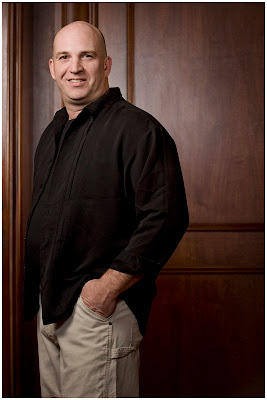Q&A: Dealing with Glare from Dark Wood Backgrounds
"How do you deal with glare on dark wood in background for portraits? Is this covered in Lighting 101 or 102?"
Actually, it is covered in L102, if a little obliquely. And yes, pretty much any time you light into dark wood as a background you are gonna get some blowback.
But rather than look at this as a problem, I prefer to think of it as a feature…
__________
So first, let's get some consistency in our terms. What Jefferson considers to be a "glare" is something I think of as a specular highlight. To me, a glare is what I can expect from the missus when I say something a little … insensitive.
But what we are really talking about here is a reflection of a light source in your background. And dark wood, with a typical satin (or worse) finish, has a very efficient reflective surface as compared to its true tonal value. So it is going to throw a light right back at you.
One way around this is to light obliquely, as in when you are dealing with glasses. But I think this is a missed opportunity. If you position a relatively soft light source (such as an umbrella) near the lens axis, you can get double duty out of it.
One, it makes a very nice on-axis fill light. And two, the specular from a soft light source is large in size and muted in intensity. Take this example:

This was one of many quick, run-and-gun portraits I did for a computer software company during a convention at a hotel. They were using the photos for testimonials in trade mags. We only had a few minutes to shoot each one, and we had to scrounge our backgrounds from what was available.
In this case, dark wood.
There are two light sources here, both speedlights. The key is an 43" umbrella, upper camera left. The fill is another umbrella, firing right over my right shoulder.
Glare? Yep, we got it. But is it controlled in size and intensity by the size of the light source we are using. And our shooting/lighting angle controls the location of the glare. Or, as I call it, the specular.
So we kinda harnessed it into a third light source. It is working in its primary function as fill. But it is also kinda like a background light. And a much-needed one at that. We would be in trouble with his shadow-side shoulder without it.
If you want an idea of how much trouble, check out the separation we are getting between his camera-right shirttail and the wall. That would be a big problem for us up top without the specular.
And once I am close to the proper position on the fill light, I can move the specular around slightly by raising or lowering my camera position slightly. Doesn't take much, either. Because there is a reflection involved, the angle doubles the result. If I move my camera down three inches the specular will appear to drop six inches.
That's very quick and easy to modulate when you are in a rush, as we were. Way better than constantly moving a light source.
To be sure, this would have looked like crap if our fill light was small -- say, a ring flash. The specular would have been much smaller, and way more intense. Not good. So this is one of those times you want to know enough to switch up for the desired effect.
Speculars are one of the most useful lighting controls you have. You can learn more about them in this section of Lighting 102.
__________
New to Strobist? Start here | Or jump right to Lighting 101
My new book: The Traveling Photograher's Manifesto
Permalink
<< Home